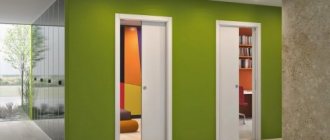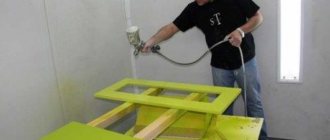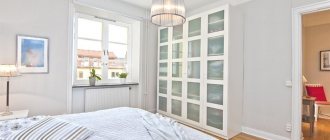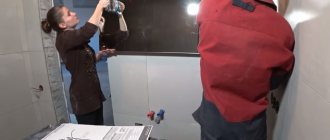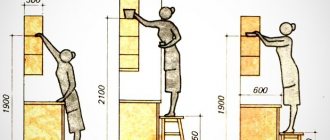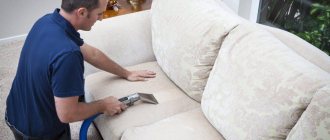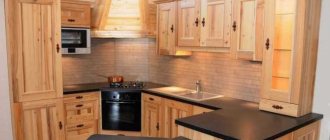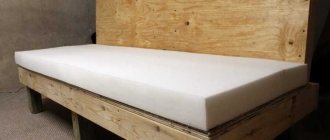The exotic beauty of aquarium fish and the measured hum of the compressor can relieve tension and become a source of peace. In addition, the aquarium becomes a stylish element in the interior of the home. When purchasing it, the owner needs to consider what the new acquisition will stand on. You can't put it on the floor or table. A cabinet of a special design is required that can withstand heavy weight without deformation.
The meaning, role and features of aquatombs
The aquarium stand should not only match the design of the apartment, but also fulfill the main task - to be a reliable support and withstand a lot of weight. Therefore, such cabinets have a number of features. They have a specific design and are made of special material.
If a small aquarium with a capacity of 50 liters is placed on a table or stand, then over time the tabletop will begin to sag under its weight. And any deformation of the surface provokes cracking of the aquarium glass. For tanks of 100 or 200 liters, you will definitely need special furniture, which is equipped with additional vertical partitions inside.
The requirements for moisture resistance of the material from which the cabinet is made have the same goal - to prevent deformation. When cleaning the aquarium, changing the water and servicing the aqua system, moisture gets onto the support. Over time, unevenness appears on the tabletop, the load is distributed unevenly, which leads to the formation of cracks in the glass.
Aquarium furniture has holes on the countertop or back wall for aquarium communications - wires and hoses. The free space is equipped with shelves and is used to store additional equipment and supplies for caring for the tank and fish.
Photo gallery of aquarium stands:
From a safety point of view
When performing any manipulations with the aquarium, there is a possibility of accidentally touching or dropping aquarium accessories on the TV. Water that accidentally gets on electrical appliances will also not lead to anything positive.
Therefore, the best option is to place the fish house as far as possible from heating radiators and other equipment, where splashes of water will not reach.
Mr. Tail explains: requirements for cabinets
Externally, the aquarium stand looks like a chest of drawers or a TV stand. But the requirements for its production are completely different. This applies to materials, height, and frame features.
All cabinet walls, as well as internal partitions, must be 25 mm or more. In this case, the back wall is made as thick as all the parts of the case. If the volume of the aquarium exceeds 100 liters, the internal supports are made of metal, and the walls are reinforced with metal profiles. Otherwise, the side panels of the cabinet will begin to sag, causing uneven distribution of the load.
The dimensions of the tank and countertop must match each other. As a result, the pressure on the cabinet is evenly distributed across all vertical partitions. In this case, visually the entire structure looks more harmonious and monolithic.
The optimal height is 90 cm. Exceeding this standard deprives the aquarium structure of stability and requires additional supports.
Aquarium stands are often made without legs. But it is better if the support is equipped with screw legs, this is necessary to ensure the stability of the aquarium on an uneven floor surface.
The requirements for countertops are higher than for other surfaces of the cabinet. They should be no thinner than 3 cm, perfectly smooth and repel moisture. Top panels made of stone are not suitable for aquarium furniture - they are too heavy and place additional stress on all vertical supports. For large aquariums, it would be useful to have a side around the tabletop. For production, natural hardwood, laminated chipboard or MDF are used.
Varieties: shape, size, material
It is much more convenient when the cabinet is purchased complete with an aquarium. In this case, the seller will recommend the best option taking into account the shape and size of the tank. If the stand is selected separately, you need to know the features of certain sizes and shapes of the products.
Size
The furniture and tank must match each other. Based on size, three groups can be distinguished:
- Small ones. They are suitable for small aquariums with a volume of 70-100 liters. The length of the table top is usually 60 cm.
- Average. Capable of withstanding a load of 100-150 liters with a length of 70-80 cm;
- Big ones. The length of such furniture exceeds 1 m, has a massive tabletop and an impressive base. Such designs can withstand tanks of 250 liters or more.
A correctly selected cabinet shape helps solve several problems at once: it serves as a stand for an aquarium, becomes an additional decoration for the room, and saves space. The most popular are:
| Form | Peculiarities |
| Rectangular | A standard option, since most aquariums have a classic rectangular shape. Fits well into any interior. It has a reliable frame and plenty of space inside to hide aquarium structures. Easy to assemble. |
| Oval, semicircular | Ideal for round containers. Often made to order for non-standard tank shapes. For such cabinets, the requirements for the material are increased - the wood must be of durable varieties. It has a complex design, assembly skills are required. Suitable for small aquariums only. |
| Square | Used for square and round aquariums. Saves space and looks harmonious in small living rooms. Easy to assemble. |
| Corner | The purpose of the corner set is to save space in a small room. Due to its shape, it allows the installation of large tanks - up to 200 liters, while occupying a small non-functional area. Suitable for rectangular aquariums, provided that the container does not protrude beyond the edges of the furniture. When purchasing, you should take into account the complexity of assembling the model. |
The main requirements for the materials from which furniture for aquariums is made are strength and moisture resistance. For this they use: chipboard, MDF, wood and metal.
For small aquariums with a capacity of up to 100 liters, laminated chipboard is suitable. Products made from this material look stylish, non-bulky and at the same time affordable for most. MDF is stronger than chipboard.
An additional advantage is the wide choice of colors for such panels. The buyer is given the opportunity to choose a model whose color best fits into the interior of the home. Products made from such panels can withstand large tanks up to 200 liters.
Solid wood furniture is often made to order. These are expensive, stylish and reliable models. Any durable type of wood will do - maple, ash, oak. To repel moisture, the wood is varnished and lasts a very long time.
Metal is used only for the manufacture of the internal frame. When exposed to water, it quickly corrodes and loses its required strength. Therefore, the outside of the cabinet is made of any material. Such designs guarantee high strength and reliability for tanks over 250 liters.
Design
Making a stand for an aquarium with your own hands begins with creating a drawing. When designing, it is taken into account that the main purpose of the structure is to support the weight of the tank and ensure its location at a height convenient for observation. If you do not have the skills to draw up diagrams, you should use special software, for example, the Astra furniture designer.
You can take ready-made sketches and adjust them to the size of your aquarium.
When creating a drawing, you should consider the following points:
- The length and width of the tabletop should be slightly larger than the same parameters of the tank. The design will look neat if you don’t leave more than 3–5 cm at the edges. The cabinet that fully matches the size of the aquarium looks interesting.
- The height of the stand depends on its location. The optimal value for any room is 80–90 cm. If the installation is carried out in a bedroom or living room, where aquarium inhabitants are observed while sitting or lying down, 70 cm from the floor level is sufficient.
- The plan usually indicates a rectangular shape. But you can also make a corner tabletop, where the container will stand parallel to the long side.
- A cabinet for an aquarium of 200 liters or larger volume must be equipped with a metal frame. For 100–150 l, reinforcement is allowed, but it is not necessary.
In addition to the main frame, the drawings may take into account additional details: shelves, drawers, doors. Partitions will help ensure the stability of a long stand; the distance between them should not exceed 30–50 cm. So, for an internal space 1.2 m long there will be at least two such elements.
Advantages of a folding table-cabinet with drawers, criteria for choosing furniture
The dimensions of the cabinet and the aquarium itself must match
The optimal height of the stand is 80–90 cm
Corner cabinets look original
If the aquarium is designed for more than 200 ml, you need to take care of the metal frame of the cabinet
Device and selection rules
Despite a number of features, the arrangement of such furniture is simple. First, tighten all the frame parts: side, top and bottom. Then the vertical posts are installed. The maximum distance between them is 50 cm. After this, panel cladding is performed.
If the model does not provide a frame, then all the parts are connected to each other, starting from the back wall. For convenience, models are equipped with hinged or sliding doors. Shelves are installed inside, which are attached to vertical posts, enhancing the strength of the entire structure.
When choosing, you need to consider several points:
- Aquarium volume. Large volumes require frame-reinforced furniture.
- Tank shape. Both models must match each other.
- Perfect evenness of the tabletop. The surface is considered unsuitable even if it has an unevenness of 1 mm. It is desirable to have sides or a non-slip coating on the surface of the cabinet.
- The presence of holes in the countertop or back wall - depending on the location of the aquarium, free space inside the cabinet for placing aquarium equipment.
- Appearance of the product. It should be in harmony with other interior elements.
If all the details are thought out, then the buyer receives reliable, practical and beautiful furniture for long-term use.
DIY aquarium stand
You can make a bedside table for an aquarium yourself. This process is labor-intensive, painstaking and costly. Therefore, you should start this business yourself only in the following cases:
- if it is impossible to deliver the cabinet;
- if there is no stand of the required shape and size in the store;
- with a non-standard aquarium model.
A high-quality stand will only be possible if all the operating features of such stands are taken into account: stability, water resistance of the surface, internal equipment with vertical stands at a distance of 30-50 cm, and the weight of the filled aquarium. Depending on this, materials are selected and a metal or wooden frame is installed.
The exact dimensions of each part, their thickness and quantity are determined in advance. To do this, at the initial stage they make a diagram, then draw up a detailed drawing. After this, they begin to manufacture the cabinet, following the algorithm of actions:
- They cut parts to the required sizes, independently or in a furniture workshop.
- Process the edges of parts if necessary.
- Drill holes for bolts and for confirmation.
- Connect the box parts, starting from the back and side walls. In this case, you need to very accurately align all the angles. The slightest deviation is unacceptable.
- Install internal vertical posts.
- They hang doors and attach shelves.
- Cut holes for wires and hoses.
If the manufacture of a cabinet requires a frame, the execution pattern may differ. A wooden beam or metal profile will be required, depending on the required strength of the entire installation. If the bars are precisely fitted and correctly connected, then such a frame will not be inferior to a metal one. Assembly of a metal frame is possible using welding or bolts.
Then you need to cut the cladding parts to the required sizes. If the frame is steel, pre-drill holes for fastenings. The cladding is attached to the rear wall. After installing all the panels, they must be connected to each other. Doors and shelves are attached last.
After the cabinet has been installed in its proper place, you can begin installing the aquarium. Additional fastenings are not required, but to balance out the slightest unevenness, it is recommended to place a polystyrene foam pad under the bottom of the tank.
Working on a cabinet is difficult and requires skill and precision. Therefore, if possible, it is better to purchase it in a store complete with an aquarium.
Manufacturing process
The manufacture of a cabinet begins with the selection of materials and drawing up a drawing. First you will need to cut the blanks to size, then assemble the frame, install the table top and legs. At the final stage, holes are drilled in the back wall for wiring, doors are hung, and decorative elements are attached.
Advantages of glass TV stands, ways to place equipment
Material cutting
Work begins with preparing all the parts that will be attached to each other. The process of their manufacture consists of the following stages:
- Drawing patterns on paper and cutting with scissors.
- Attaching paper templates to the materials from which the bedside table will be made.
- Cutting blanks using a jigsaw or other tools.
- Manufacturing of stiffening ribs, which for aquariums of about 100 liters in size can be made of chipboard.
If you have the right tools, experience and space, you can do the sawing yourself. If there are no conditions, and there is nothing to cut blanks for the cabinet with, you should contact a furniture store or workshop - for example, the one where the material is purchased.
Ordering sizing tape along the cut edges will help increase the attractiveness of the product; such a solution will also reduce the amount of waste during installation.
Drawing of the cabinet
Cutting the material
Cabinet elements
Edge banding
Frame assembly
Assembling an aquarium stand with your own hands begins with the frame. To do this, all wooden beams or metal corners are connected using the chosen method (welding or self-tapping screws). All angles and distances are accurately measured - even a 1-2 degree difference will lead to serious distortion and deformation of the table, and therefore increase the risk of the tank falling.
The walls are attached to the frame on the outside and partitions on the inside. When performing work, use a screwdriver and confirmats (euro screws). For them, you will have to prepare holes in the structural elements in advance. When choosing drills, take into account that the diameter should be 1 mm less than that of the Euroscrew.
Material marking
Drilling holes
Connecting structural elements
Assembling the stand
Tabletop installation
The next step is attaching it to the tabletop frame. The process consists of only three stages:
- Make holes at diagonally opposite corners of the structure.
- Install the countertop.
- The element is attached to the frame.
The fastest and easiest way to secure the tabletop is with self-tapping screws on top. However, in this case, the fastener heads remain visible, so they often choose to install a horizontal surface on corners or metal figure-eight holders.
Tabletop installation
Installation of shelves, drawers, hanging doors
Making a nightstand usually involves making compartments or drawers. To protect access to the internal space, doors are used that will have to be suspended:
- The process begins with the manufacture and adjustment of the doors to the dimensions of the aquarium stand blank.
- Mark the installation locations for the hinge sockets.
- Make the necessary holes.
- The doors are fixed to hinges on the sidewall.
You can simplify the process of closing doors by using door closers. Horizontal shelves are installed inside. And one compartment is usually divided using drawers, for the correct fastening of which it is necessary to accurately install the guides in suitable places.
Types of TV tables, popular shapes, sizes, colors
Fastening the shelves
Door installation
Attaching the legs, preparing holes for cables
When the aquarium cabinet is almost ready, it is placed on its side and attached to the bottom of the stand leg. It is recommended to install them strictly along the edges of the frame to avoid deflections or subsidence. It is advisable to place heel pads under the legs to protect the floor from scratches.
The penultimate stage of manufacturing the aquarium stands serves to prepare the back wall for laying cables, water and air hoses. The surface is drilled in one or several places. In order not to make a mistake, they first determine in what places the devices will be located - lighting, compressors, filters.
Laying cables, water and air hoses
Decoration
Furniture made from unfinished materials such as chipboard should be additionally decorated. To do this, they use different techniques: painting in the desired colors, pasting with film or fabrics. Sometimes even sheet plastic is used. Before you begin, it is advisable to see what a finished cabinet for an aquarium with your own hands will look like - photos of similar designs can be found on thematic resources.
In pursuit of beauty, it is important not to forget that one of the main criteria for choosing a material is moisture resistance.
Doors can be glass. The best option is made of tempered dark glass. It is necessary to attach handles to them, which will not only allow you to easily open the resulting cabinet, but also improve its design.
Handles on the doors make it easier to open and access the contents of the cabinet
A popular design option for a cabinet is doors made of tempered dark glass.
The pattern on the doors will add originality to the product
Drawings of different options for stands for aquariums
Click on any drawing picture to enlarge it:
465 liters 140 liters
60 liters
117 liters
320 liters
350 liters
138 liters
470 liters

